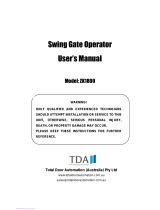15 FAAC MODEL 844 Slide Gate Operator
5.4.2. J7 Terminal Block - Power Supply (Fig. 23)
POWER SUPPLY (Terminals PE-N-L):
PE : Ground connection
N : AC Power ( Neutral )
L : AC Power ( Line )
5.4.3. J6 Terminal Block - Motors / Flashing Lamp (Fig. 23)
MOTOR - (Terminals MOT-C, MOT-1, MOT-2): Motor con-
nection (see Section 6.5).
LAMP - (Terminals LAMP L, LAMP N): Flashing lamp
output same VAC as input; max 60W.
5.4.4. J1 Terminal Block - Accessories (Fig. 23)
Consult the relevant tables for a detailed description of
operation in the different logics
OPEN A - “Total Opening” Command (Terminal 1): any
pulse generator (push-button, detector, etc.) which, by clo-
sing a contact, commands total opening and/or closing of the
gate leaf.
To install several total opening pulse generators, connect the
N.O. contacts in parallel (Fig. 35).
OPEN B - “Partial Opening” or “Closing” Command
(Terminal 2): any pulse generator (push-button, detector,
etc.) which, by closing a contact, commands partial opening
and/or closing of the gate leaf. In the B, C and B/C logics, it
always commands gate closure.
To install several partial opening pulse generators, connect
the N.O. contacts in parallel (Fig. 35).
FSW OP - Opening Safety Devices Contact (Terminal 3):
The purpose of the opening safety devices is to protect the
leaf movement area during opening. During opening, in the
A-AP-S-E-EP logics the safety devices reverse the move-
ment of the gate, or stop and restart the movement when it
is released (see advanced programming in Section 5.5.2).
During the opening cycle in logicsthe B, C and B/C, they
interrupt movement. They never operate during the closing
cycle.
If the Opening safety devices are engaged when the gate
is closed, they prevent the opening movement.
To install several safety devices, connect the N.C. contacts in
series (Fig.25).
NB: If no opening safety devices are connected, jumper
inputs FSW OP and -TX FSW (Fig. 26).
FSW CL - Closing Safety Devices Contact (Terminal 4):
The purpose of the closing safety devices is to protect the
gate movement area during closing. During closing, in the
A-AP-S-E-EP logics, the safety devices reverse the move-
ment of the gate, or stop and reverse the movement when it
is released (see advanced programming in Section 5.5.2).
During the closing cycle in logics B, C and B/C, they interrupt
movement. They never operate during the opening cycle. If
the Closing safety devices are engaged when the gate is
open, they prevent the closing movement.
To install several safety devices, connect the N.C. contacts in
series (Fig.25).
NB: If no closing safety devices are connected, jumper
terminals FSW CL and -TX FSW (Fig. 26).
STOP - STOP Contact (Terminal 5):
Any device (e.g. a push-button) which, by opening a contact,
stops gate movement.
To install several STOP devices, connect the N.C. contacts in
series (Fig. 25).
NB: If STOP devices are not connected, jumper the STOP
and - terminals.
SAFE - EDGE Safety Device Contact (Terminal 6):
The purpose of the "edge" safety device is to protect the
leaf movement area during opening/closing. In all logics,
during opening and closing, the safety device reverses gate
movement for 2 seconds. If the safety devices operate again
during the 2-seconds reversing time, it stops movement
(STOP) without any reversing.
If the Edge safety device is engaged while the gate is clo-
sed or open, it prevents movement.
To install several safety devices, connect the N.C. contacts in
series (Fig.25).
NB: If edge safety devices are not connected, jumper the
SAFE and - inputs (Fig. 26).
– Negative for power supply to accessories
(Terminals 7 and 8)
+ 24 VDC - Positive for power supply to accessories
(Terminals 9 and 10)
Important: Accessories max. load is 500 mA. To calculate the
load, refer to the instructions for the individual accessories.
RX OP/CL
TX OP/CL
SAFE
+
+
OPEN
B
A
OPEN
OP
CL
Fig. 34
Connection of a pair of closing photocells and a pair of
opening/closing photocells
Fig. 35
Connection of two N.O. contacts in parallel
(e.g. Open A, Open B)





















